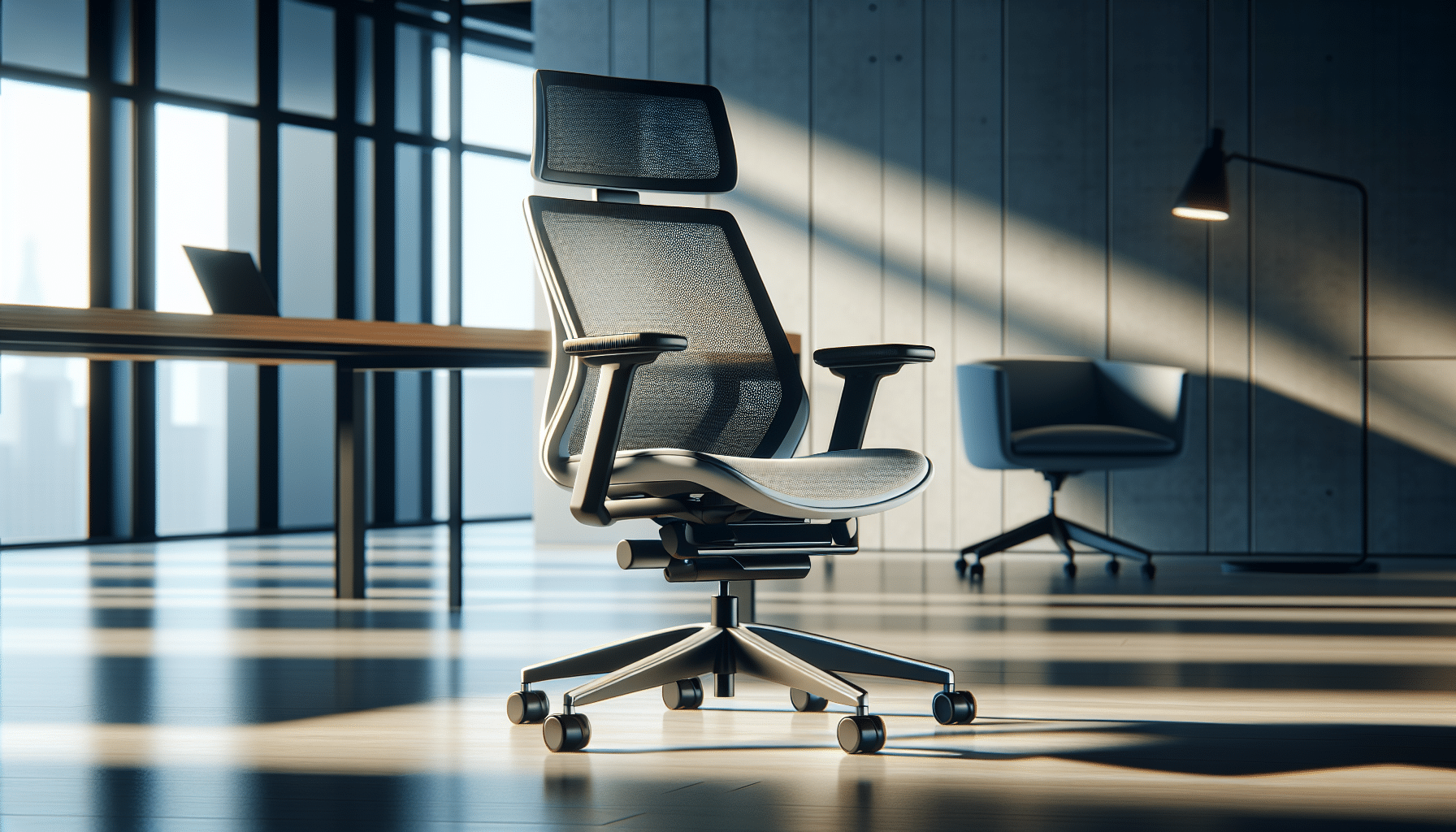
Transform Your Workday with Ergonomic Chairs
Best office ergonomic chair guide: Transform your workspace into a haven of comfort and productivity with our top picks.
Last Updated on 15/09/2025
We’ve all felt the strain of long hours at our desks, the stiffness in our backs, and the nagging ache that seems to creep up our spines. It’s a common challenge in our quest for productivity and success, often leaving us searching for solutions that promise relief. The good news is, ergonomic office chairs are designed to address these very pain points.
By prioritizing comfort and posture support, these chairs not only alleviate discomfort but also enhance our overall well-being and work efficiency. Let’s explore how an ergonomic design can be the key to a more comfortable and productive work environment.
Key Takeaways
- Ergonomic chairs promote healthy posture with lumbar support and adjustable features, enhancing comfort and productivity.
- Key features like adjustable height, tilt mechanism, and breathable mesh backs prevent fatigue and support natural posture.
- Choosing high-quality materials and construction ensures durability, while design elements contribute to aesthetic appeal in the workspace.
Understanding Ergonomic Design
Ergonomic office chairs are revolutionizing the way we think about workplace comfort and productivity. With features like lumbar support and adjustable armrests, these chairs are at the forefront of promoting a healthy posture. The design of these chairs is focused on supporting the natural curve of the spine, which is essential for long hours spent at a desk.
What sets ergonomic chairs apart is their ability to adjust to the individual’s body, providing personalized support. This not only enhances comfort but also significantly reduces the risk of developing posture-related discomforts. The benefits of ergonomic design extend beyond immediate comfort, contributing to long-term health and well-being, making it a smart investment for anyone looking to improve their workspace. For a wide selection of office chairs that embody these principles, visit Realspace ergonomic office chair collection.
Essential Features of an Ergonomic Office Chair

An ergonomic office chair comes loaded with features designed to support your body’s natural posture. Adjustable height is crucial for ensuring that your feet are flat on the ground, aligning your knees and hips for optimum comfort. The tilt mechanism and 360-degree swivel add layers of functionality, allowing for movement and flexibility, which is vital for staying comfortable and focused throughout the day.
The importance of a mesh back cannot be overstated, offering breathability and reducing sweat and heat buildup. Together, these features create a seating experience that not only prevents fatigue but also promotes a healthier working posture. Adjustable armrests further contribute to this by reducing strain on the shoulders and wrists, underscoring the chair’s role in fostering an environment where comfort and productivity go hand in hand.

Energi-24 Office Chair Synchro Tilt Fabric Height-Adjustable Armrest Height-Adjustable Seat Black 150 kg Air Care

Energi-24 Office Chair Synchro Tilt Fabric Height-Adjustable Armrest Height-Adjustable Seat Blue 150 kg Air-Care

Viking Realspace Signum Office Chair Synchro Tilt Fabric 3D Armrest Height-Adjustable Seat Black 110 kg
Lumbar Support and Back Pain Relief
One of the cornerstone features of an ergonomic office chair is its lumbar support. This is designed to fit the curvature of your spine, providing targeted support that alleviates strain on your lower back. Adjustable lumbar settings allow for a custom fit that’s flexible enough to accommodate various body types, ensuring everyone can find their perfect support level.
This tailored support is crucial for those looking to mitigate or prevent back pain. By encouraging a natural sitting posture, ergonomic chairs help distribute body weight evenly, reducing pressure points and the risk of discomfort. It’s an effective way to protect your back, ensuring that long periods spent sitting don’t lead to pain or discomfort.
| Feature | Description | Benefit |
|---|---|---|
| Adjustable Lumbar Support | Supports the natural curve of the spine. | Prevents and alleviates lower back pain. |
| Mesh Back | Provides breathability and reduces heat buildup. | Enhances comfort during long sitting periods. |
| Adjustable Armrests | Can be adjusted for height and width. | Reduces shoulder and wrist strain. |
| Height Adjustable | Allows for feet to rest flat on the ground. | Aligns hips and knees to reduce strain. |
| Tilt Mechanism | Enables reclining for movement and relaxation. | Allows for personalized seating comfort. |
| 360-Degree Swivel | Facilitates easy access to workspace without straining. | Increases mobility and accessibility. |
Choosing the Right Material and Construction
The construction and materials of an ergonomic office chair play a pivotal role in its overall comfort and durability. Opting for chairs built with high-quality, durable materials ensures they can withstand the rigors of daily use. Breathable fabrics like mesh allow for air circulation, keeping you cool and comfortable even during long work sessions.
Different materials offer different benefits, from easy maintenance to enhanced support and comfort. Premium foam cushions conform to your body, providing personalized support that adapts to your movements. A robust frame supports weight evenly, maintaining stability and extending the chair’s lifespan. When selecting your next office chair, consider these factors to ensure you’re choosing a chair that meets both your comfort and durability needs.
| Material | Comfort | Durability | Maintenance |
|---|---|---|---|
| Mesh | High breathability, reduces sweat | Varies, generally durable | Easy to clean with a vacuum |
| Leather | Premium feel, less breathable | Highly durable with proper care | Requires regular conditioning |
| Fabric | Soft, varies in breathability | Depends on weave and type | May require professional cleaning for stains |
| High-density Foam | Contours to body, provides support | Highly durable, retains shape | Typically covered, depends on outer material |
Balancing Comfort with Aesthetic Design
In the modern workspace, ergonomic office chairs do more than just provide comfort; they also contribute to the office’s aesthetic appeal. Today’s chairs blend seamlessly into any decor, available in a variety of styles and colors to match any office environment. This fusion of design and functionality ensures that your office not only feels good to work in but also looks great.
The attention to detail in the design of ergonomic chairs is evident in their sleek contours and supportive features. Chairs that offer a combination of supportive seating, adjustable headrests, and elegant lines demonstrate that you don’t have to compromise on style to enjoy the benefits of ergonomic seating. Whether for a home office or a corporate setting, there’s an ergonomic chair that combines the ultimate in comfort with sleek, modern design.
Conclusion
Choosing the right ergonomic office chair is pivotal in transforming your work environment into a space of comfort and productivity. We’ve explored the essential features, from adjustable lumbar support to the importance of selecting high-quality materials, addressing common pain points associated with prolonged sitting.
This guide aims to empower you with the knowledge to make an informed decision, ensuring your investment promotes not just a healthier posture but also a more enjoyable workday. Let the search for the perfect ergonomic chair be a hopeful step towards achieving your best work-life balance.

Frequently Asked Questions
How does lumbar support in an office chair prevent back pain?
Lumbar support in an office chair is designed to match the natural curve of your lower back, providing targeted support that prevents the lumbar spine from slouching and reduces strain on back muscles. Consistent use of chairs with proper lumbar support can significantly reduce the risk of developing back pain by maintaining proper posture, ensuring the spine is aligned, and distributing body weight evenly across the seat and backrest. This support is crucial for individuals who spend prolonged periods sitting, as it helps maintain the spine’s natural ‘S’ curve, thereby preventing the common discomfort and potential chronic conditions associated with poor sitting habits.
Can ergonomic chairs improve productivity at work?
Yes, ergonomic chairs can significantly improve productivity at work by providing the necessary support to maintain a comfortable and healthy posture throughout the day. Comfortable seating reduces the need for frequent breaks due to discomfort, keeps energy levels high, and minimizes distractions caused by aches and pains. By promoting proper posture, these chairs also enhance concentration and reduce fatigue, enabling longer focus periods. Additionally, the adjustability of ergonomic chairs allows users to customize their seating position to suit their tasks, further boosting efficiency and work output.
What materials are best for ergonomic office chairs?
The best materials for ergonomic office chairs combine durability, comfort, and breathability. Mesh is popular for backrests due to its breathable nature, preventing overheating and providing support. For the seat, high-density foam covered with fabric or leather offers lasting comfort and is resistant to wear. Leather adds a touch of luxury and is easy to clean, while fabric provides a softer feel and breathability. The base and frame materials, typically made from steel or aluminum, ensure stability and support. Ultimately, the choice of materials should reflect personal comfort preferences, workplace needs, and durability requirements.
How do you adjust an ergonomic office chair for optimal posture?
To adjust an ergonomic office chair for optimal posture, start by setting the chair height so that your feet are flat on the floor, and your knees are at a 90-degree angle. The backrest should be tilted and locked in a position that supports the natural curve of your spine, with lumbar support fitting snugly into your lower back. Adjust the armrests so that your shoulders are relaxed, and your elbows are at a 90-degree angle when typing. If your chair has a seat tilt function, adjust it to a comfortable position that allows your thighs to be parallel to the floor. Properly adjusting your chair ensures you maintain an ergonomic posture, reducing strain and preventing pain.
What features should you look for when choosing the best ergonomic office chair?
When choosing the best ergonomic office chair, look for features that support a healthy posture and provide comfort throughout the day. Key features include adjustable lumbar support to fit the curve of your lower back, adjustable seat height to ensure your feet rest flat on the floor, and adjustable armrests to relieve shoulder strain. A tilt mechanism allows for movement and relaxation, while a 360-degree swivel offers easy access to your workspace without straining. Additionally, a chair with a breathable backrest material, like mesh, and a seat cushion made from high-density foam ensures comfort and durability. These features combined allow for a customizable seating experience tailored to individual needs, promoting well-being and productivity.






